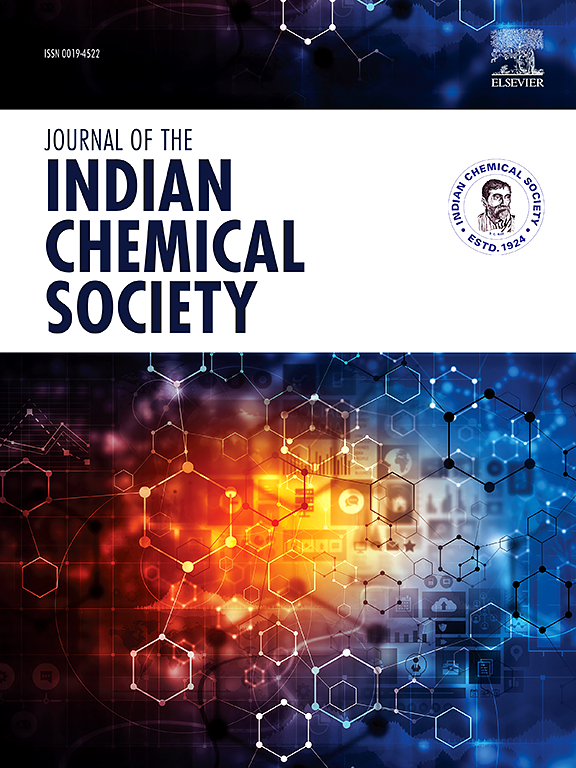通过制造浸渍银纳米粒子的陶瓷滤水器,在使用点提高水质
IF 3.2
4区 化学
Q2 CHEMISTRY, MULTIDISCIPLINARY
引用次数: 0
摘要
在这项研究中,我们成功地合成了浸渍银纳米粒子的陶瓷过滤系统,专门用于有效的水净化。通过x射线衍射(XRD)、x射线荧光(XRF)、紫外光谱(UV-Vis)、能量色散x射线扫描电镜(SEM- edx)、扫描电子显微镜(SEM)和透射电子显微镜(TEM)分析,对所获得的材料进行了广泛的表征。XRD分析检测到材料的晶粒尺寸在16 ~ 22 nm之间。此外,XRF分析显示,材料中的主要成分是SiO2(94%),这源于沙子和稻壳中二氧化硅的高含量。SEM分析表明,材料的主要结构为球形聚集体。紫外可见分析证实了银纳米粒子(Ag-NPs)在420 nm左右存在光学等离子体振荡。此外,SEM-EDX分析显示Si, O和Ag0在体系内均匀分布,而TEM图像显示材料中Ag0的光滑模式和排列。在测试的不同比例中,用沙子、稻壳灰和小麦粉的混合物以60:40:7.5的比例处理的样品表现出最高的性能,达到了99%的显著效果,去除大肠杆菌和其他水污染物,包括重金属(Cr、Cu、Mn、Ni、Zn和Pb)、BOD、浊度和总溶解固体。这些结果强调了该系统在有效去除各种污染物(特别是大肠杆菌)方面的潜力,使其在水处理和净化应用中具有很大的前景。本文章由计算机程序翻译,如有差异,请以英文原文为准。

Enhancing water quality at the point of use through fabrication of silver nanoparticles impregnated ceramic water filters
In this study, we present the successful synthesis of ceramic filtration systems impregnated with silver nanoparticles, designed specifically for effective water purification. The materials obtained underwent extensive characterization through X-ray diffraction (XRD, X-ray fluorescence (XRF), Ultra Violet-Spectroscopy (UV–Vis), Scanning electron microscopy with energy-dispersive X-ray spectroscopy (SEM-EDX), Scanning electron microscopy (SEM), and Transmission electron microscopy (TEM) analyses. XRD analysis detected the crystallite size of the materials ranged from 16 to 22 nm. Furthermore, XRF analysis revealed that the predominant component in the materials was SiO2 (94 %), which originated from the high silica content found in sand and rice husks. SEM analyses demonstrated the formation of spherical aggregates as the primary structure of the materials. The UV–Vis analysis confirmed the presence of optical plasmon oscillation of Silver nanoparticles (Ag-NPs), observed around 420 nm. Moreover, SEM-EDX analysis showed a uniform distribution of Si, O, and Ag0 within the systems, while TEM images revealed smooth patterns and arrangements of Ag0 in the materials. Out of the different ratios tested, the sample treated with a mixture of sand, rice husk ashes, and wheat flour in a 60:40:7.5 ratio displayed the highest performance, achieving a remarkable >99 % removal of E. coli and other water contaminants including heavy metals (Cr, Cu, Mn, Ni, Zn, and Pb), BOD, turbidity, and total dissolved solids. These results underscore the potential of the systems in effectively removing a variety of pollutants, with a particular emphasis on E. coli, making them highly promising for water treatment and purification applications.
求助全文
通过发布文献求助,成功后即可免费获取论文全文。
去求助
来源期刊
CiteScore
3.50
自引率
7.70%
发文量
492
审稿时长
3-8 weeks
期刊介绍:
The Journal of the Indian Chemical Society publishes original, fundamental, theorical, experimental research work of highest quality in all areas of chemistry, biochemistry, medicinal chemistry, electrochemistry, agrochemistry, chemical engineering and technology, food chemistry, environmental chemistry, etc.

 求助内容:
求助内容: 应助结果提醒方式:
应助结果提醒方式:


